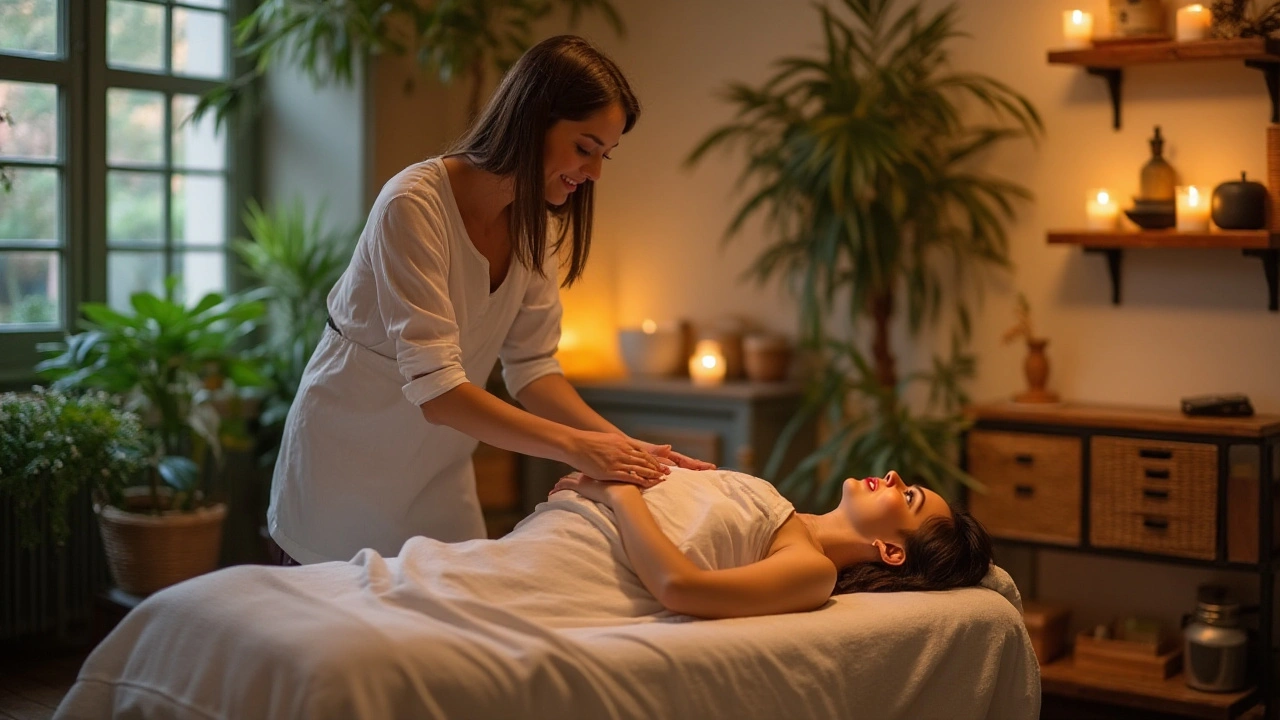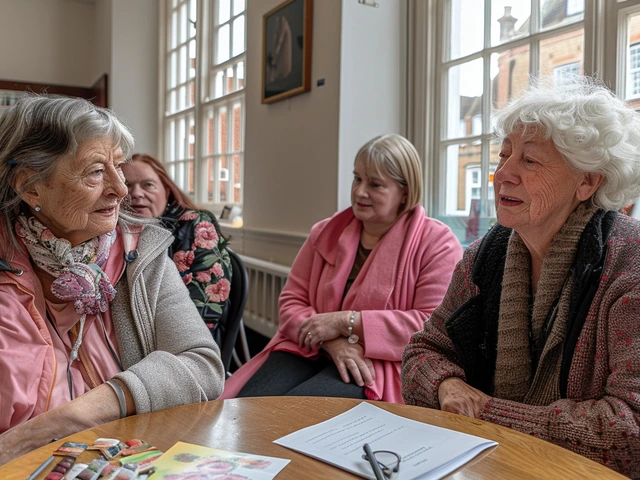Reiki, an ancient Japanese healing technique, has found its place in modern wellness routines. By focusing on energy transfer, Reiki aims to promote physical, emotional, and spiritual healing.
This intriguing practice has roots dating back to the early 20th century but has become increasingly relevant in today's fast-paced world. People are discovering its potential to complement traditional medicine and enhance overall well-being.
We'll explore the history behind Reiki, how it works, and its multiple benefits. You'll also find practical tips on integrating Reiki into your daily life and how to choose a suitable practitioner to guide you on this healing journey.
- Origins and History of Reiki
- How Reiki Works
- Benefits of Reiki
- Reiki in Daily Life
- Finding a Reiki Practitioner
Origins and History of Reiki
The story of Reiki begins with a remarkable man named Mikao Usui, who was born in Japan in 1865. Usui came from a family with a long history of Buddhist priests, and he himself was well-versed in various forms of spiritual and healing practices. Despite his wealth of knowledge, Usui felt there was something missing, a deeper understanding of how energy could be harnessed for healing purposes.
In the early 1920s, Usui embarked on a 21-day meditation retreat on Mount Kurama, a sacred mountain in Kyoto. During this period of fasting and deep introspection, he reportedly experienced a profound spiritual awakening. This epiphany led to the creation of what we now call Reiki, a term derived from the Japanese words 'Rei', meaning 'universal', and 'Ki', meaning 'life energy'. Usui began to develop a system for energy healing that was simple yet deeply effective, designed to channel this universal life energy to facilitate healing.
Usui's practice gained followers quickly, and he established the Usui Reiki Ryoho Gakkai, a society dedicated to the practice and teaching of Reiki. Interestingly, Usui also trained several naval officers, which helped to spread his teachings beyond the typical spiritual community. Reiki found its way to the West largely thanks to Hawayo Takata, a Japanese-American woman who learned the practice in Japan during the 1930s and brought it back to Hawaii. Takata played a key role in popularizing Reiki in the United States, training 22 Reiki Masters before her passing in 1980.
Records show that Usui passed away in 1926, but his legacy continues to flourish worldwide. Today, Reiki has evolved into various forms, but the core principles laid down by Usui remain intact. These include the Five Reiki Principles, which Usui encouraged his students to adopt as part of their daily lives. These principles focus on cultivating a sense of gratitude, honesty, patience, kindness, and effort in all endeavors. By following these, Reiki practitioners aim to foster a holistic approach to health and well-being.
The spread of Reiki in modern times is fascinating. According to a 2007 survey published by the National Center for Complementary and Integrative Health, over 1.2 million adults and 161,000 children in the United States had experienced Reiki. These numbers have only grown as more people seek complementary and alternative therapies for well-being and stress reduction. Dr. Ann Baldwin, a respected researcher in the field of energy medicine, once said, "Reiki provides a gentle, non-invasive method to balance the body's energy, which can lead to significant improvements in both physical and emotional health."
Reiki's path from a spiritual retreat on a Japanese mountain to a globally recognized healing practice is a testament to its enduring relevance. People today continue to seek out Reiki not only for its healing properties but also for the profound sense of peace and balance it can bring to their lives. As we delve deeper into this ancient art, it becomes clear that Reiki has much to offer to our modern world, transcending cultural and geographical boundaries to touch the lives of many.
How Reiki Works
At its core, Reiki works on the principle of energy transfer. This form of energy therapy believes in channeling universal life energy through the practitioner's hands to the person receiving the treatment. Energy flows through pathways in the body, often referred to as meridians, chakras, and aura layers. During a session, the Reiki practitioner places their hands lightly on or just above the client's body, acting as a conduit for healing energy.
The flow of energy during a Reiki session can feel different for everyone. Some people experience warmth, tingling, or a sense of calm washing over them. The goal is to remove blockages and balance the body’s energy centers, which promotes overall healing and well-being. A typical session lasts about an hour, and the person receiving treatment usually lies down fully clothed on a massage table while soft music plays in the background to enhance relaxation.
Mikao Usui, the founder of Reiki, discovered these principles through extensive meditation and research in the early 1920s. He combined traditional Japanese techniques with his findings to develop what we now know as Reiki. According to Reiki philosophy, when our energy is low or blocked, we are more likely to experience stress and illness. When it's high and flowing freely, we're more capable of being happy and healthy.
William Lee Rand, a notable Reiki master, states, "Reiki energy is infused with a wisdom that transcends our human understanding. It has its way of finding the areas in our bodies and spirits that most need healing."The belief in this wisdom-driven energy makes Reiki a unique experience because while the practitioner sets the intention for healing, the energy itself knows where to go and what to do. The relationship between the practitioner and the recipient is symbiotic; both parties engage in an energetic exchange that promotes mutual well-being.
For those new to Reiki, it can sound a bit mystical, but empirical studies have shown promising results. For instance, one study published in the Journal of Evidence-Based Complementary & Alternative Medicine found that Reiki could positively influence physical and psychological factors, including a reduction in pain and anxiety levels. Another study showed that hospital patients who received Reiki reported higher levels of satisfaction regarding pain management than those who didn't.
To summarize, Reiki works by channeling life energy through the practitioner's hands to encourage balance and healing in the body. It focuses on unblocking and balancing energy pathways, which can lead to improved physical, emotional, and spiritual health. By tapping into the body's natural healing processes, Reiki offers a holistic approach to well-being, making it an effective complement to conventional medical treatments.

Benefits of Reiki
Reiki offers numerous benefits that cater to multiple aspects of well-being. One of the most immediate effects people experience is a sense of calm and relaxation. By channeling energy through the hands of a practitioner, Reiki helps the body enter a state of deep rest, which can be incredibly refreshing for those who lead busy lives.
Physical healing is another significant benefit of this ancient practice. Reiki has been found to accelerate healing processes by enhancing the body's natural ability to repair itself. Many individuals with chronic pain or acute injuries have reported reduced pain levels after sessions. Studies have shown that Reiki can ease the side effects of chemotherapy, reduce pain after surgery, and support people dealing with conditions like migraines and arthritis.
There's also a notable impact on mental and emotional health. When life gets stressful, our minds can become overwhelmed, making it hard to focus and stay positive. Reiki helps in clearing out negative energy, which leads to a more balanced emotional state. It can reduce symptoms of anxiety and depression, providing a more stable and peaceful mind.
A profound sense of spiritual growth is often cited as a benefit of practicing Reiki. Whether you're deeply spiritual or not, the energy work involved can open up paths to greater self-awareness. Many people find that regular Reiki sessions help them tap into their inner selves, providing insights and encouraging personal development.
Because Reiki can be adapted to fit individual needs, it offers customized healing experiences. While some might focus on physical pain relief, others may look for emotional or spiritual healing. A skilled Reiki practitioner can tailor sessions to address specific concerns, making each experience unique and effective.
Reiki's benefits are not confined to the session itself. Regular practice can lead to long-term changes such as improved sleep, heightened immunity, and more balanced energy levels. This ancient art complements many other wellness practices, serving as a bridge that enhances other types of treatments and therapies.
"I've been practicing Reiki for over a decade, and its impact on my life has been transformational," says Dr. Maria Johnson, a holistic health expert. "Not only has it improved my physical well-being, but it has also deepened my emotional connections with others."
While everyone experiences Reiki differently, its potential for holistic healing is universal. It's a simple, non-invasive practice that anyone can try, making it an accessible addition to your health and wellness toolkit. Whether you seek to alleviate physical pain, reduce stress, or develop a deeper understanding of yourself, Reiki can offer profound benefits.
Reiki in Daily Life
Integrating Reiki into your daily routine can be a transformative experience that enriches both mind and body. This ancient healing method can turn mundane moments into opportunities for growth, balance, and peace. The beauty of Reiki lies in its simplicity and accessibility. Anyone can practice it, regardless of age or experience.
One of the easiest ways to incorporate Reiki into your day is through self-healing sessions. Begin your morning by dedicating a few minutes to a simple self-Reiki practice. Find a quiet place where you won’t be disturbed. Sit or lie down comfortably, and place your hands on different parts of your body, starting with your head and moving downwards. Close your eyes, take deep breaths, and allow the energy to flow. This practice not only helps prepare you for the day ahead but also sets a positive tone.
The middle of the day can be a perfect time for brief Reiki breaks. If you find yourself overwhelmed or stressed at work, take five minutes to center yourself. Place your hands over your chest, take deep breaths, and visualize the energy flowing through you. This can help clear your mind and reduce stress, boosting productivity and focus. As people spend more time on digital devices, it's also beneficial to give your eyes and head a little extra Reiki love.
Evenings offer another ideal opportunity for using Reiki. Incorporate it into your relaxation routine, perhaps in tandem with meditation or a warm bath. Focus on areas where you feel tension or discomfort. Holding your hands over these spots can promote relaxation and ease physical strain. Integrating Reiki into your bedtime routine can improve sleep quality by helping you wind down and release any lingering anxieties from the day.
Reiki can also enhance interactions with others. Practicing Reiki before or after a difficult conversation can provide clarity and compassion. Some even find incorporating Reiki into family routines beneficial. Practicing Reiki on children can promote a sense of security and calm, helping them manage school-related stress. Pets can also benefit from Reiki. Animals are incredibly receptive to energy work, and a few minutes of Reiki can help soothe an anxious pet.
Household plants and even your living environment can benefit from Reiki. By directing energy toward your plants, you can promote their growth and health. Similarly, using Reiki in your home can create a peaceful and harmonious atmosphere. As people are increasingly looking for holistic and natural ways to enhance their well-being, integrating Reiki into everyday life offers a multitude of benefits.
"Reiki is a simple, natural and safe method of spiritual healing and self-improvement that everyone can use," says The International Center for Reiki Training. This simplicity makes it easy for everyone to integrate it into their daily lives.
The versatility of Reiki is one of its greatest strengths. Whether you need a brief energy boost or deep healing, this ancient practice fits seamlessly into modern life. The more you practice, the more attuned you become to the energy, allowing for even greater benefits. By making Reiki a part of your daily routine, you can foster a sense of balance, peace, and well-being in an increasingly chaotic world.

Finding a Reiki Practitioner
Embarking on the journey to incorporate Reiki into your life begins with finding a practitioner who resonates with your personal energy. This process, while sometimes daunting, is essential in ensuring you reap the full benefits of this healing art.
Start by researching local practitioners. Word of mouth can be invaluable; ask friends or family if they know a qualified Reiki practitioner. If personal recommendations are unavailable, online resources such as Reiki association directories can be helpful. These directories often list certified professionals within your area, complete with reviews and contact information.
Certifications and training are crucial aspects to consider. A reputable Reiki practitioner will typically have completed a series of training levels. The initial level, often called Reiki I, introduces students to the basics of the technique. Reiki II and Reiki Master trainings delve deeper, enabling the practitioner to channel stronger healing energies. Always inquire about your prospective practitioner's training and certification background.
Getting a sense of the practitioner's demeanor and energy is another important step. Many practitioners offer initial consultations, either free or at a reduced rate. Use this opportunity to ask questions about their approach, experience, and how they conduct sessions. You want to feel comfortable and secure in their presence, as the practitioner-client energy exchange is central to the effectiveness of Reiki.
"A genuine Reiki healer will create a sacred space, making you feel safe and seen," says Dr. Mikao Usui, the founder of the practice. This sense of safety can greatly enhance the healing process, making it easier for you to open up emotionally and energetically.
Once you have narrowed down your options, it's time to schedule an appointment. Here, trust your intuition. The right practitioner should feel aligned with your needs and expectations. Remember that it's not uncommon to try a few different practitioners before finding the one who fits best.
Reiki is a deeply personal and transformative practice. Engaging with it through a well-suited practitioner can significantly enhance your overall wellness. Take the time to find someone who not only has the technical skills but also creates an environment of trust and healing.
For those looking for more specifics, consider visiting local wellness centers or holistic health expos. These venues often host a variety of practitioners, allowing you to meet several at once. This can be a convenient way to compare different styles and methods practiced within the Reiki community.





